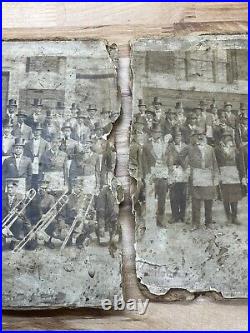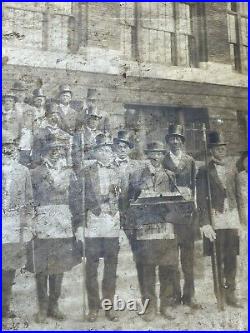Buffalo Ny African American Musicians Local 533 A. F. M. Roosevelt Memorial Band






















RARE BUFFALO NY AFRICAN AMERICAN FEDERATION OF MUSICIANS UNION LOCAL 533 A. FOUND IN A BARN IN SOUTH ALABAMA THIS SCARCE PANORAMIC PHOTOS SHOWS THE AFRICAN AMERICAN FEDERATION OF MUSICIANS LOCAL 533 OUT OF BUFFALO NEW-YORK PLAYING FOR THE ROOSEVELT MEMORIAL SO IM ASSUMING FROM THE YEAR 1919.
AS YOU CAN TELL ITS IN NEED OF RESTORING OR AT LEST REFRAMED BEHIND GLASS TO HELP KEEP IT FROM FURTHER DAMAGE SIZE IS APX 8 x 40 INCHES COMES IN TWO PIECES. I TRIED TO FIND ANOTHER EXAMPLE OF THIS PHOTO WITH NO LUCK. A little history About the band.
Originally, there was only one Buffalo musicians union, Local 43. This all white Local which was part of the American Federation of Musicians refused to include African American musicians.As a result, a separate union, Buffalo Local 533 was formed on February 3, 1917. Buffalo then became the eighth city in the United States, since the 1896 founding of the American Federation of Musicians, with racially segregated musician's local unions. A year after Local 533 was formed, a close knit group of people independent from the Association but comprised of it's members, formed a social club where, according to charter member and retired President of Local 533, Dr. Jackson, the musicians used to hang out after they finished their jobs at night. You could get a trotter-a plate of pork, a pig foot, a plate of beans and a bottle of beer - for 25 cents.
(Davis) Before the Colored Musicians Club found its permanent home at 145 Broadway in 1934, it was housed in other locations. These residences included the union headquarters on Michigan Avenue, then 96 Clinton at the corner of Oak Street, and the Masonic Temple at 168 Clinton Street. When the Colored Musicians Club moved into the property at 145 Broadway it was merely a vacant storefront. The actual building had been constructed between 1880 and 1900 and it initially housed the shop of boot and shoemaker Charles Zifle, then Michael McNamara's cigar and tobacco stand, a billiards parlor, several union locals and Niagara China and Equipment Company. The Colored Musicians Club received its charter and became incorporated on May 14, 1935.
At this point, the club utilized the space upstairs for practice, rehearsals, and performances while, downstairs, the union would hold its meetings. This club, which was a separate entity from Local 533, and gave the members a sense of community outside of their professional and family environments.
Its purpose was stated as follows in its certificate and consequently in its Constitution. [To] foster the principles of unity and cooperation among the colored musicians of Erie County, N. To develop and promote the civic, social, recreational and physical well-being of its members; to improve and enhance the professional and economic status of its members; to stimulate its members to greater musical expression; to encourage and develop a fuller appreciation of music on the part of its members and the public; and generally to unite its members in the bonds of friendship, good fellowship and mutual understanding. Later, during the 1950's, more and more jazz bands were becoming racially integrated. This racial integration showed a positive step in terms of race relations in the country but the initial results of the desegregation were not always positive for African American Locals because they had less power in terms of size and influence than their white counterparts.
In 1964, the American Federation of Musicians President, Herbert Kenin, told the separate locals that the Federation had to desegregate or be in violation of the Civil Rights Act, scheduled to take effect on July 1, 1965. As reported in the International Musician, Locals 43 and 533, Buffalo, New York, merged effective January 1, 1969. The merged Local would be known as'Buffalo Musicians' Association, Local 92, A. (Davis) Regrettably, this new merged Local showed preference for the white musicians and, in many cases, put African American musicians out of work. In many other cities, African American Locals lost their real estate after mergers and were, then, over-powered by the larger, more powerful white Locals.
This one distinction (the separate-ness of the Club from the Local) preserved the Colored Musicians Club and continued to allow African American musicians to have a place that they could call their own in Buffalo. In 1979, the Club was granted historic landmark status.
In 1999, the Club was designated a historical preservation site. Today, the Colored Musicians Club is the only remaining African American club in the entire United States and, as such, it actively encourages historical research and preservation of the history of jazz in Buffalo.